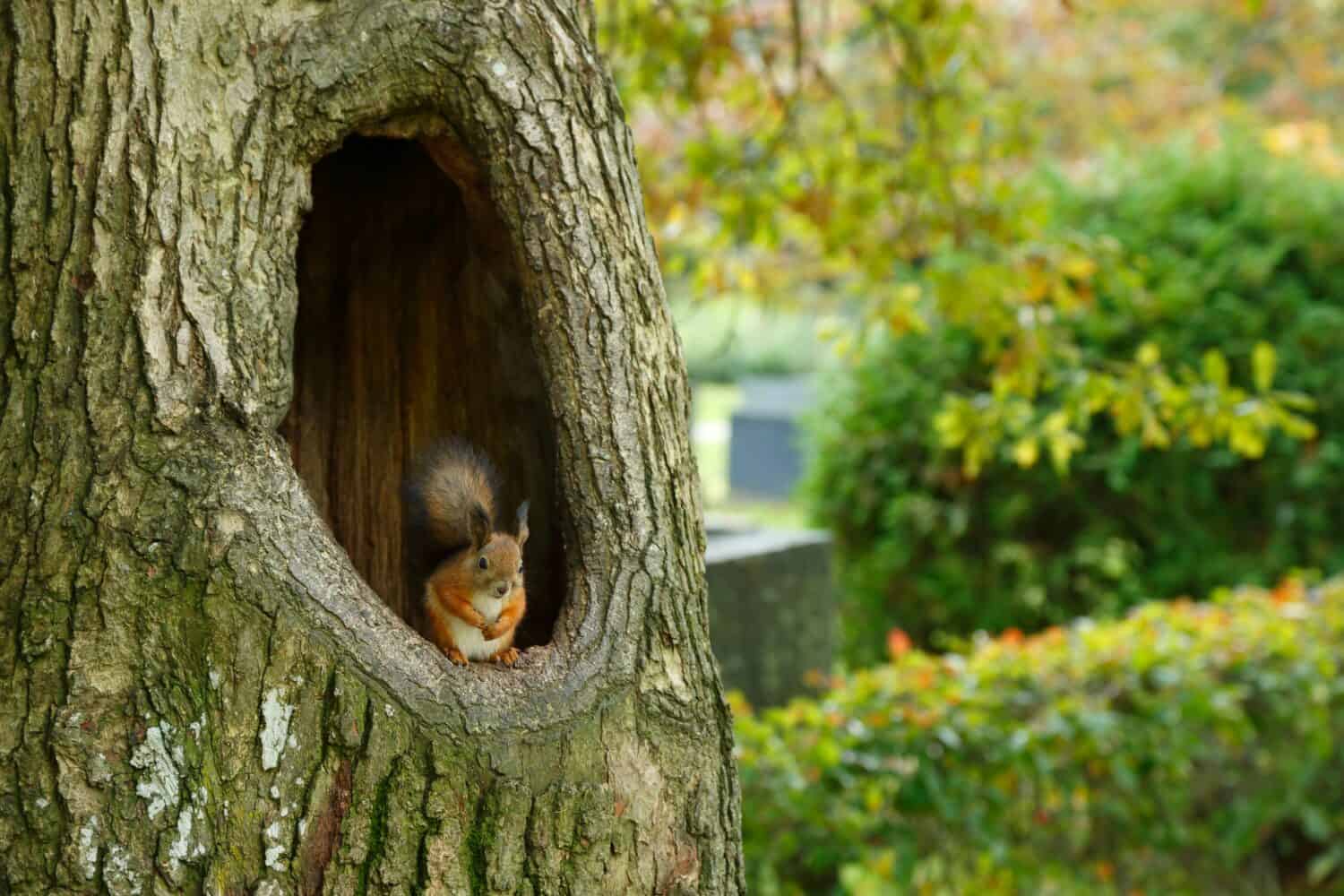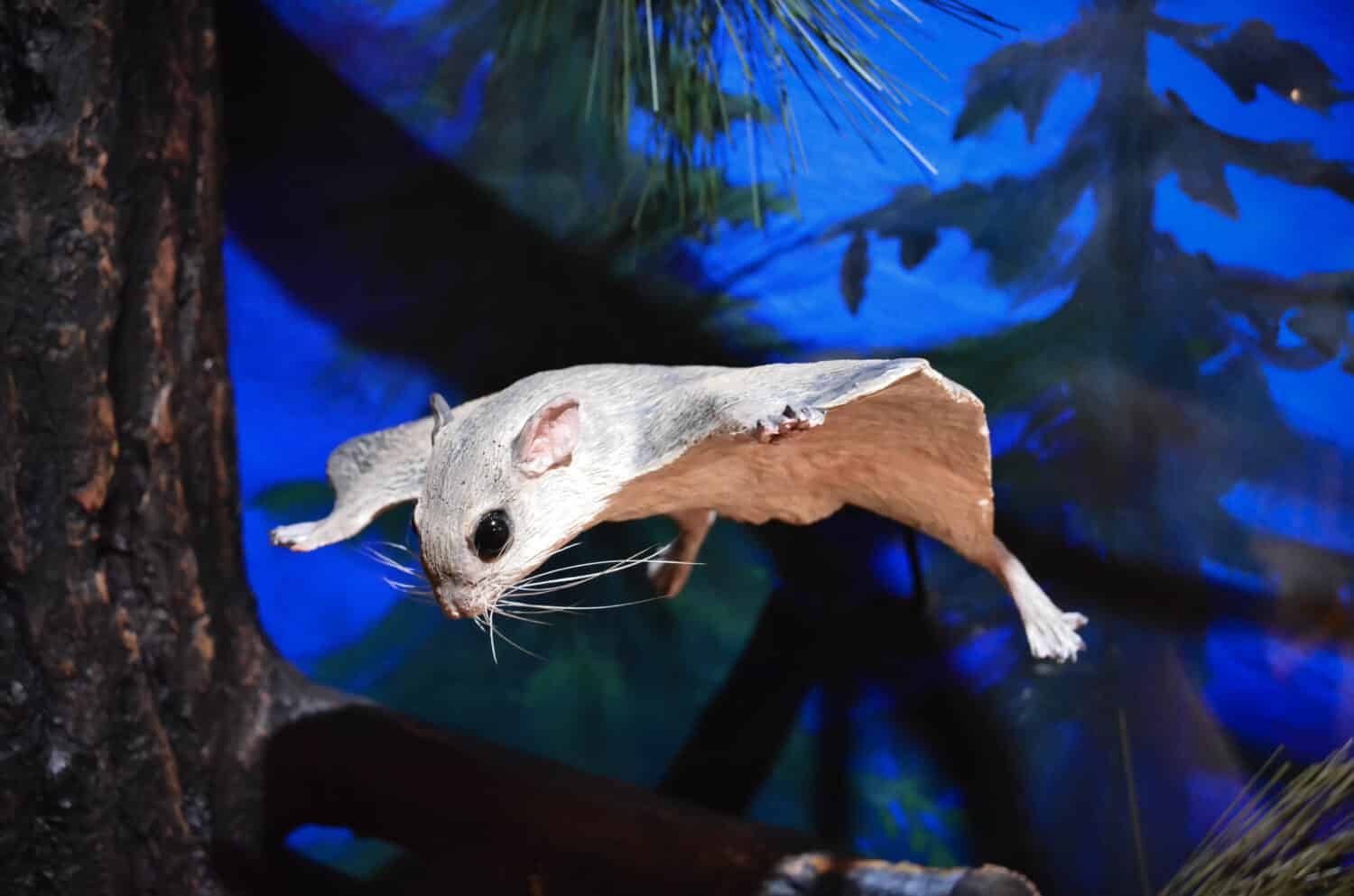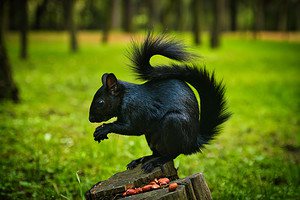Like people, animals have ways of dealing with bad weather. Many instinctively know when Mother Nature is about to unleash harsh conditions and take advance precautions. But when it comes to rain, where do squirrels go for shelter from the storm? And do they seek it as soon as they feel a drop of rain on their furry heads?
Three of North America’s most common varieties of squirrels each have their special way of coping with inclement conditions.
One thing we know for sure, however, is when it comes to staying dry, squirrels have other creatures beat in a very special way.

Squirrels frequently build nests high in the treetops but will make use of any cozy spots they find for nesting or shelter.
©Antero Aaltonen/Shutterstock.com
Taking Shelter
Gray squirrels, also called eastern gray squirrels (Sciurus carolinensis) frequently build, or use, a nest called a drey, high up on a tree limb. But since they are tree-dwelling members of the rodent family, it makes sense that they prefer sleeping high in the treetops.
If that doesn’t sound like the best place to be when it rains, these squirrels aren’t limited to just one nest or even one style of nest. Oftentimes, they just pick up and move to another. And some nests are certainly more practical when it comes to taking shelter.
A better place in which they often take refuge is the hollow of a tree. Squirrels don’t create these holes but are perfectly happy to take advantage of a naturally occurring one or an opening made by a woodpecker.
Unlike a drey, any nook or cranny a tree may offer is the perfect place for a squirrel to stay dry during heavy rain.

Ground squirrels dig their own nests, which can be quite extensive having many chambers and entrances.
©Charles T. Peden/Shutterstock.com
The Ground’s the Limit
The ground squirrel, a rodent in the Sciuridae family, knows its territory and where to scamper for shelter.
Since its typical habitat is an underground burrow, this type of squirrel is familiar with the best hideaways and how to find them. And unlike their more opportunistic cousins, the tree squirrels, these creatures can dig their own lairs.
Along with providing them shelter in a storm, underground nests once abandoned become homes for other down-to-earth animals such as snakes and rodents.
Gliding High in the Night Sky
Somewhat resembling a bat, the flying squirrel (Pteromyini) doesn’t technically fly but rather glides in the night sky hunting for insects.

The
flying squirrel
may appear to be flying but is actually gliding between trees.
©andysartworks/Shutterstock.com
Propelling themselves into the air from trees, flying squirrels have a unique membrane called a patagium, that turns them into an instant hang glider! The patagium is a loose fold of skin that stretches from the wrist to the ankle. The flying squirrel thus resembles a flat airplane in “flight” with its arms and legs spread wide.
If this gliding rodent needed shelter from a storm, it would look for the familiar places it uses for nesting. Those would include crevices and holes in trees as well as tree openings made by woodpeckers.

A squirrel’s tail can be used like an umbrella.
©blightylad-infocus/iStock via Getty Images
Eating in the Rain
Squirrels don’t always take shelter during rainy weather. And that’s due to their exceptional tails.
Possessing a long, bushy tail is definitely an asset during inclement conditions. A squirrel’s tail is a multi-purpose appendage that’s very useful during the rain.
Typically curled over its back, the thick fur provides ample protection. Using its tail as an umbrella, a squirrel can continue to eat while staying dry.
A Tail of Many Uses!
Along with rainy-day duties, a squirrel’s tail has many other useful functions.
An important one is communication. Squirrels “talk” to each other with a variety of tail flicks. During mating season, a tail shake in front of a female squirrel is a type of question — is it okay to approach?
Other times tail action means the squirrel is alarmed or frightened and ready to run.
Another reason why their tails are so important has to do with balance and temperature control. If you’ve ever watched squirrels jumping from branch to branch or walking a power line like a tightrope, it’s obvious they have an amazing sense of balance. That’s due in large part to their tails.
A squirrel’s tail also plays a role in regulating its body temperature. It can act as both a cooling mechanism in the summer or a body heater in the winter by automatically controlling blood flow.
But living outdoors can be tough going. Especially when really bad weather hits.
How Do Squirrels Survive Hurricanes?
The high winds and drenching rain of a hurricane leave many animals vulnerable. Squirrels take cover in the same places where they would nest. Unless an area floods, ground squirrels have ready-made shelters for high wind conditions.
Despite their native abilities and instincts, however, even the most adept of squirrels can be displaced during rough weather.
Most vulnerable are babies who may get blown out of their nests during a storm.
One famous storm baby is Jill. She fell out of her nest during Hurricane Isaac in Louisiana and became a squirrel influencer when pictures of her and the tiny teddy bear she was given to comfort her flooded the internet.
While many squirrels survive severe weather unscathed, oftentimes they need help. That’s one more reason why keeping the number for a local wildlife rehabber in your list of contacts is a good idea.
The photo featured at the top of this post is © ztsaries/Shutterstock.com
Thank you for reading! Have some feedback for us? Contact the AZ Animals editorial team.







